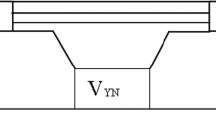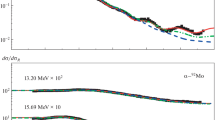Abstract
We have recently constructed two very successful n-\(^9\)Be optical potentials (Bonaccorso and Charity in Phys Rev C89:024619, 2014). One by the Dispersive Optical Model (DOM) method and the other (AB) fully phenomenological. The two potentials have strong surface terms in common for both the real and the imaginary parts. This feature makes them particularly suitable to build a single-folded (light-) nucleus-\(^9\)Be optical potential by using ab-initio projectile densities such as those obtained with the VMC method (Wiringa http://www.phy.anl.gov/theory/research/density/). On the other hand, a VMC density together with experimental nucleon–nucleon cross-sections can be used also to obtain a neutron and/or proton-\(^9\)Be imaginary folding potential. We will use here an ab-initio VMC density (Wiringa http://www.phy.anl.gov/theory/research/density/) to obtain both a n-\(^9\)Be single-folded potential and a nucleus-nucleus double-folded potential. In this work we report on the cases of \(^8\)B, \(^8\)Li and \(^8\)C projectiles. Our approach could be the basis for a systematic study of optical potentials for light exotic nuclei scattering on such light targets. Some of the projectiles studied are cores of other exotic nuclei for which neutron knockout has been used to extract spectroscopic information. For those cases, our study will serve to make a quantitative assessment of the core-target part of the reaction description, in particular its localization.
Similar content being viewed by others
References
Tanihata, I.: Neutron Halo Nuclei. J. Phys. G Nucl. Part. Phys. 22, 157 (1996)
Bonaccorso, A., Charity, R.J.: Optical potential for the n-9Be reaction. Phys. Rev. C 89, 024619 (2014)
Wiringa, R.B.: http://www.phy.anl.gov/theory/research/density/
Pieper, S.C., Wiringa, R.B.: Quantum Monte Carlo Calculations of Light Nuclei. Annu. Rev. Nucl. Part. Sci. 51, 53 (2001)
Xiangzhou, C., Jun, F., Wenqing, S., Yugang, M., Jiansong, W., Wei, Y.: In-medium nucleon-nucleon cross section and its effect on total nuclear reaction cross section. Phys. Rev. C 58, 572 (1998)
De Vries, H., De Jager, C.W., De Vries, C.: Nuclear charge-density-distribution parameters from elastic electron scattering. At. Data Nucl. Data Tables 36, 495–536 (1987)
Bertulani, C.A., De Conti, C.: Pauli blocking and medium effects in nucleon knockout reactions. Phys. Rev. C 81, 064603 (2010)
Satchler, G.R., Love, W.G.: Folding model potentials from realistic interactions for heavy-ion scattering. Phys. Rep. 55, 183 (1979)
Bonaccorso et al., A.: (in preparation)
Fan, G.W., et al.: Structure of Li8 from a reaction cross-section measurement. Phys. Rev. C 90, 044321 (2014)
Fukuda, M., et al.: Density distribution of 8B studied via reaction cross sections. Nucl. Phys. A 656, 209 (1999)
Bonaccorso, A., Carstoiu, F.: Optical potentials of halo and weakly bound nuclei. Nucl. Phys. A 706, 322 (2002)
Author information
Authors and Affiliations
Corresponding author
Additional information
The work of R.J. Charity was supported by the U.S. Department of Energy, Office of Science, Office of Nuclear Physics under Award No. DE-FG02-87ER-4036.
Rights and permissions
About this article
Cite this article
Bonaccorso, A., Carstoiu, F., Charity, R.J. et al. Differences Between a Single- and a Double-Folding Nucleus-\(^\mathbf{9}\)Be Optical Potential . Few-Body Syst 57, 331–336 (2016). https://doi.org/10.1007/s00601-016-1082-4
Received:
Accepted:
Published:
Issue Date:
DOI: https://doi.org/10.1007/s00601-016-1082-4




